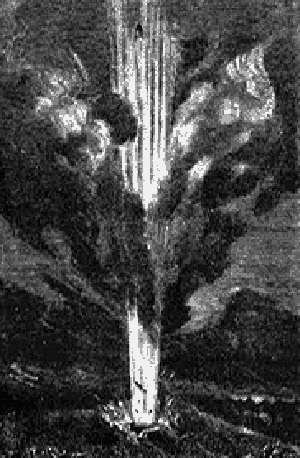Columbiad

The Columbiad was Jules Verne's Moon gun, as described in his 1865 novel From the Earth to the Moon. It consisted of a cannon 274 meters long with a bore of 2.74 meters cast in a vertical well in Florida. The first 61 meters of the barrel was filled with 122 tons of guncotton which, when ignited, was supposed to propel an aluminum capsule (containing three men and two dogs) to a speed of 16.5 kilometers per second. After deceleration through Earth's atmosphere, the shell would have a residual velocity of 11 kilometers per second – sufficient to reach the Moon. Although Verne made some scientific errors, he used real engineering analysis to arrive at the design of his cannon and lunar projectile. In this passage from his book he provides extensive detail:
During the eight months which were employed in the work of excavation the preparatory works of the casting had been carried on simultaneously with extreme rapidity. A stranger arriving at Stones Hill would have been surprised at the spectacle offered to his view. At 600 yards from the well, and circularly arranged around it as a central point, rose 1,200 reverberating ovens, each six feet in diameter, and separated from each other by an interval of three feet. The circumference occupied by these 1,200 ovens presented a length of two miles. Being all constructed on the same plan, each with its high quadrangular chimney, they produced a most singular effect. It will be remembered that on their third meeting the committee had decided to use cast iron for the Columbiad, and in particular the white description. This metal, in fact, is the most tenacious, the most ductile, and the most malleable, and consequently suitable for all moulding operations; and when smelted with pit coal, is of superior quality for all engineering works requiring great resisting power, such as cannon, steam boilers, hydraulic presses, and the like. Cast iron, however, if subjected to only one single fusion, is rarely sufficiently homogeneous; and it requires a second fusion completely to refine it by dispossessing it of its last earthly deposits. So long before being forwarded to Tampa Town, the iron ore, molten in the great furnaces of Coldspring, and brought into contact with coal and silicium heated to a high temperature, was carburized and transformed into cast iron. After this first operation, the metal was sent on to Stones Hill. They had, however, to deal with 136,000,000 pounds of iron, a quantity far too costly to send by railway. The cost of transport would have been double that of material. It appeared preferable to freight vessels at New York, and to load them with the iron in bars. This, however, required not less than sixty-eight vessels of 1,000 tons, a veritable fleet, which, quitting New York on the 3rd of May, on the 10th of the same month ascended the Bay of Espiritu Santo, and discharged their cargoes, without dues, in the port at Tampa Town. Thence the iron was transported by rail to Stones Hill, and about the middle of January this enormous mass of metal was delivered at its destination. It will easily be understood that 1,200 furnaces were not too many to melt simultaneously these 60,000 tons of iron. Each of these furnaces contained nearly 140,000 pounds weight of metal. They were all built after the model of those which served for the casting of the Rodman gun; they were trapezoidal in shape, with a high elliptical arch. These furnaces, constructed of fireproof brick, were especially adapted for burning pit coal, with a flat bottom upon which the iron bars were laid. This bottom, inclined at an angle of 25 degrees, allowed the metal to flow into the receiving troughs; and the 1,200 converging trenches carried the molten metal down to the central well.
The first person to think of using a cannon to put a projectile in orbit was Isaac Newton in his Principia Mathematica. For more details on this, see Newton's orbital cannon.


